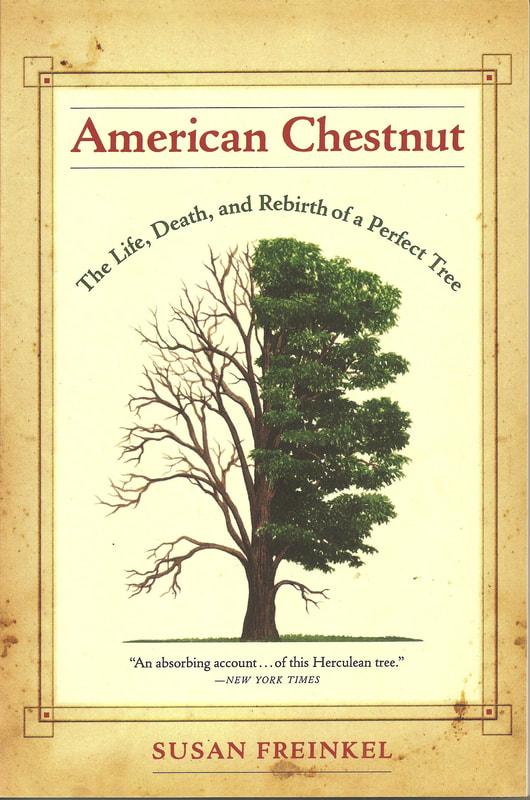 We invited our friend, Benjamin Goluboff, to submit a guest post to our blog about a recommended read. We love his mind and we think you will too! Ben has led our Ryerson Reads book discussion series for eight seasons and is a professor of English at Lake Forest College. One of the many reasons to be an obsessive reader of the New York Times is the first-rate reporting on wildlife and wildlife conservation that the Times has offered over the years. Since 2010 theTimes has featured a section called Scientist at Work: Notes from the Field. This is a series of blog posts by researchers in various disciplines studying wildlife around the world. The Times calls the series a "modern version of a field journal, a place for reports on the daily progress of scientific expeditions -- adventures, misadventures, discoveries. As with the experditions themselves, you never know what you will find." Featured scientists have included the Field Museum's Doug Stotz conducting a biological inventory in Peru's northern Amazon, and Stanford University's Caitlin O'Connell-Rodwell studying elephant societies in Namibia. A particularly fascinating blog appeared last year by Roland Kays of the New York State Museum who tracked radio-collared fishers in urban and wild settings around Albany New York. Do Fishers really prey on house cats? Do Fishers really scream? Read Kays and find out. This winter I have been reading a series of blog posts (just concluded) by John Vucetich a wildlife ecologist from Michigan Tech who leads the wolf-moose Winter Study on Isle Royale National Park. Isle Royale is an island wilderness in Lake Superior. Roadless and accessible only by ferry, Isle Royale is a kayak and backpacker destination in the summer; in winter it is the site of the longest continuous study of predator-prey dynamics in the world. Since 1958 ecologists have monitored the shifting populations of wolves and moose on the island, deriving insights about the life-cycles of both species, and dispelling the myth that predator-prey interactions are governed by the "balance of nature." Learn more about the Winter Study here: http://www.isleroyalewolf.org/overview/overview/at_a_glance.html Vucetich's posts describe a winter spent flying transects over the island and snowshoeing across its interior following the Chippewa Harbor pack as it pursues moose in the island's deep snows. Along the way we learn something of the personality of the pack, the craft and determination of the researchers, and the shifting emphasis of the long-term study. Vucetich writes: "During the first two decades that scientists observed the wolves on Isle Royale, the predators had a very strong influence on moose abundance. Then climate replaced the influence of wolves over the next two decades. Understanding nature and the lessons of long-term research may require adjusting our sense of what counts as normal." The writing is crisp and the story is well told. A recommended read for Friends of Ryerson woods, Vucetich's blog can be found at: http://scientistatwork.blogs.nytimes.com/author/john-vucetich/ Benjamin Goluboff
0 Comments
 A post by Sophie Twichell, FRW's executive director: Tonight our RYERSON READS book group will discuss Susan Freinkel's American Chestnut: The Life, Death, and Rebirth of a Perfect Tree. I am looking forward to the group's discussion of this book, led by Professor Ben Goluboff of Lake Forest College. The group will explore this lost North American tree and the Chestnut blight that killed millions of trees in the first decade of the 20th century. The blight (a type of fungus) gained entry to this country on an imported chestnut tree from Asia, which Americans began bringing into the US in the late 19th century. The fungus could kill a mature tree in just 2-3 years. By mid-century, it was estimated that the blight killed between 3-4 billion trees! That's enough trees to fill nine million acres . . . enough to fill Yellowstone eighteen hundred times over. The book also assesses the blight's impact on forest ecology and human culture, as well as discussing the ongoing project to breed a disease-resistant Chestnut. Lots of good discussion material for tonight. Although the book explains in detail the measures taken to try to stop the blight, to develop disease-resistant trees and more, while reading I focused on imagining a landscape filled with wild chestnuts. You know how people ask, "if you could go back in time, who would you like to meet?" For me, it has always been "what would I have liked to have seen." My answer is "skies darkened for days by migrating passenger pigeons" or "millions of acres of uninterruped prairie" or "the migration of millions of American bison." I look at the landscape around me and try to imagine what it would have been like to be a part of it 500 years ago. This book added a new vision for me . . . witnessing wild chestnut trees filling the forests of Appalachia. The dominion of the American Chestnut tree sprawled over more than 200 million acres, spreading the length of the Atlantic seaborad and west to Ohio, Kentucky and Tennessee. Unlike other parts of the world where the chestnut was a cultivated tree (a family with a chestnut orchard would never go hungry), here this tree was never tamed -- it remained a wild forest king. According to Freinkel, "legend has it that a squirrel could travel the chestnut canopy from Georgia to Maine without every touching the ground. Along the way it would pass over at least 1,094 places with chestnut in their names." Appalachia was defined by the chestnut, where they could account for as many as one in every four trees. Trees there were giants -- 12 feet wide and ten times as tall! Although the tree wasn't really ever formally cultivated for its nuts, people certainly gathered the nuts, which were sweeter than other types of chestnuts but also smaller (little acorn-size kernels that were difficult to peel). The trees produced nuts every year, and a single tree could bear as many as 6,000 nuts. Did you know that "nutting" parties were an annual autumn ritual in the cities and growing suburbs throughout the chestnut belt? "Not only country boys -- all New York goes a-nutting," observed Henry David Thoreau. Believe it or not, there was even a specific term, "chestnutting," for the collecting of the beautiful shiny, smooth nuts whose sweet flavor could be enjoyed raw, as well as boiled or roasted. Thoreau also wrote, "I love to gather them, if only for the sense of bountifulness of Nature they give me." The Cherokee protected their chestnuts by burning competing trees. The tree was the source of many remedies, including: tea for heart trouble or to stop the bleeding after birth, leaves for sores and as cough syrup, and galls to make an infant's navel recede. The Iroquois celebrated the chestnut tree in their story, Hadadenon and the Chestnut Tree. "Hadadenon lived alone with his uncle; the rest of the family had been killed by a group of seven evil witches. Their only food was a cache of dried chestnuts that was magically replenished at every meal. One day, Hadadenon foolishly destroyed the last of the magical nuts. His uncle cried that they would starve, so Hadadenon resolved to steal more chestnuts from a grove of trees jealously guarded by the seven witches. After many tries, he managed to get into the grove and take the nuts he needed, an act that broke the witches' curse and restored his family to life. Hadadenon gave each of his relatives a chestnut and told them to plant the seeds everywhere. The nuts, he declared, were a sacred food, to be shared forevermore with all who wanted them." The majesty of the chestnut was also captured in well-known poems, such as Henry Wadsworth Longfellow's poem published in 1841 The Village Blacksmith which begins "Under a spreading chestnut tree / the village smithy stands." Although not considered one of his major works, Robert Frost wrote a poem about the chestnut blight: Evil Tendencies Cancel Will the blight end the chestnut? The farmers rather guess not. It keeps smouldering at the roots And sending up new shoots Till another parasite Shall come to end the blight. Robert Frost (1936) To learn the status of the chestnut tree today, I hope you'll join our discussion tonight (7:30pm at Brushwood, $15 or $10 for FRW members) or read the book on your own. The selection of books for next season of RYERSON READS (our 9th season!) will be announced next week. Be sure to check our website at http://www.ryersonwoods.org/p/RyersonReads.html. After his wonderful presentation at our most recent Nature in the Classics concert with the Music Institute of Chicago Academy, we asked Jim Setapan if he would share a few more words about the relationship between nature and the great classical canon. Jim is Director of the Academy and Conductor-in-Residence at the Music Institute of Chicago. Don't forget, our last Nature in the Classics concert is coming up on Sunday, March 18! For more information, please see our Events listing.
It is clear that love of nature was of paramount interest to many of the great composers. A brief list of some of those for whom a daily communication with nature was a necessity would include Beethoven, Brahms, Mahler, Elgar, Richard Strauss, Sibelius, and Mahler. The list of works inspired by nature shows that many, many composers drew their inspiration from all matters outdoors. A short group would include: Vivaldi - The Four Seasons Respighi - The Birds Messiaen - many pieces inspired by bird calls Prokofiev - A Summer Day Joan Tower - Sequoia Ferde Grofe - Grand Canyon Suite Samuel Joners - Palo Duro Canyon Symphony Frederick Delius - On Hearing the First Cuckoo in Spring Borodin - In the Steppes of Central Asia Many German Lieder (songs) speak of the beauty of nature Beethoven - Symphony #6 (Pastorale) A list of musical pieces inspired specifically by water would include: Debussy - La Mer (The Sea) Johann Strauss jr. - Thunder and Lightning Polka Benjamin Britten - Four Sea Interludes from the Opera "Peter Grimes" Wagner - Flying Dutchman Overture Smetana - The Moldau (a river running through Prague) Handel - The Water Music Schumann - Symphony #3 (Rheinish) The inspiration continues today; the Chicago Symphony's 2012-13 season includes a section called Rivers, with music based on this feature of nature. Nature informs not only the content of classical compositions, but their form as well. Take for example the Golden Section - a sense of perfect proportion ( a division of a length so that the ration of the smaller part to the larger is the same as that of the larger part to the whole; approximately 0.618) which occurs widely in nature, and also in architecture, the visual arts...and music. Some composers used this perfect sense of proportion of form, pitch, rhythm, and tempo instinctively - Bach, Mozart, Brahms; and others, such as Bela Bartok, used it consciously. A similar relationship has often been at work in the creation of a musical motive, such as the opening of Beethoven's Fifth Symphony: its development and growth throughout a piece of music parallels nature's life cycle. What a wonderful gift nature has given us musicians! Jim Setapen Director of the Academy Conductor-in-Residence Music Institute of Chicago |
AuthorThis blog is written by the staff and partners of Brushwood Center at Ryerson Woods Archives
February 2022
Categories |
|
21850 N. Riverwoods Rd.
Riverwoods, IL 60015 224.633.2424 [email protected] ABOUT BRUSHWOOD BECOME A PARTNER VOLUNTEER AND JOB OPPORTUNITIES |
Brushwood Center at Ryerson Woods is committed to enabling the participation and enjoyment of our programming and events for all visitors. At Brushwood Center, you will have open access to accessible parking and entrance to the house, a gender neutral bathroom, and changing tables.
If you require certain accommodations in order to observe or attend our events, or have questions regarding accessibility of our facilities, please contact our Director of Public Programs and Music, Parker Nelson, at [email protected] or at (224) 633-2424 ext. 1. Programming and events at Brushwood Center are available to everyone, including but not limited to age, disability, gender, marital status, national origin, race, religion, and sexual orientation. Site Photography by: In Life Photography, Michael Kardas Photography, Ewa Pasek Photography, Brushwood Staff, and Josiah Shaw Productions |
OPEN TO THE PUBLIC Monday - Thursday & Saturday: 10am - 3pm Sunday: 1pm - 3pm and by appointment |
 RSS Feed
RSS Feed
